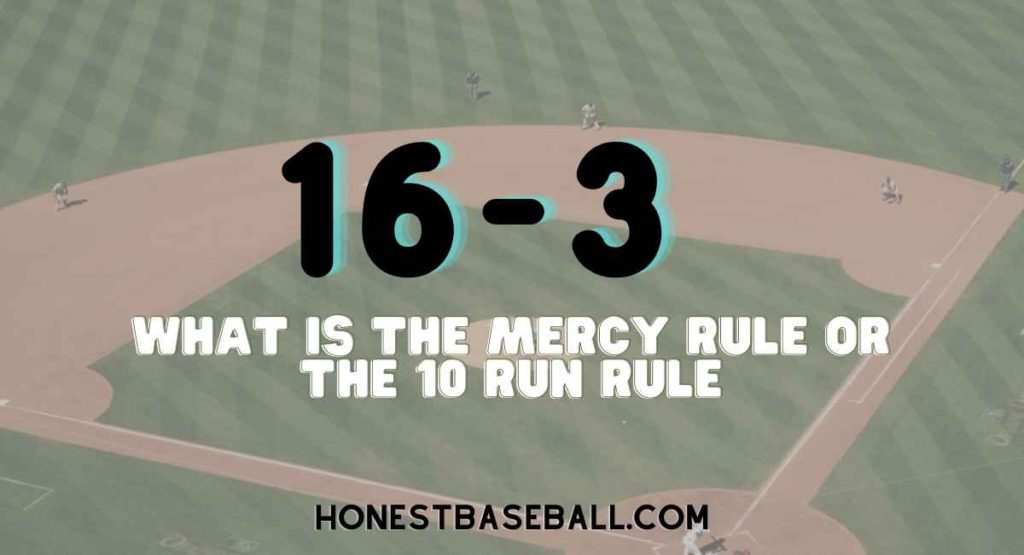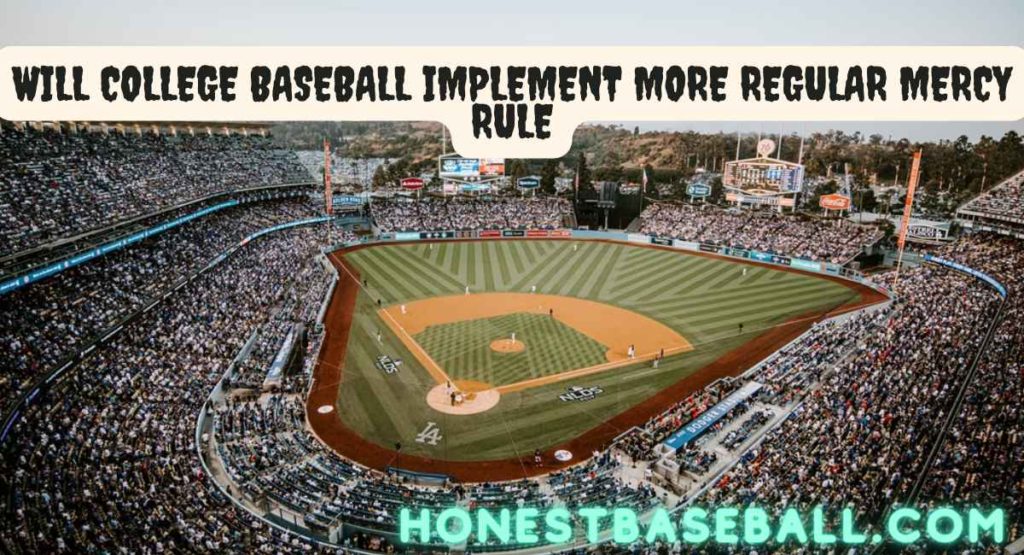Last Updated on July 24, 2022
Do you know about the 10 Run Rule or the Mercy Rule? Is there a 10 run rule in college baseball? In this article, I will discuss this and some related topics. First, let me tell you the story where I had to apply for it for the first time.
This incident happened at the very beginning of my coaching career. That was maybe the third or fourth competitive Inter Institution game. Unfortunately, on that day, my team was losing brutally. The game looked like it was happening in favor of the other team. It indeed was a terrible day for my team.
The score was 16 to 3 after five innings. My kids looked so exhausted and tired from the game that it became inevitable that we would lose. Then the other team’s coach and I reached mutual consent and called off the game.
My team was quite surprised by that situation because I was a new coach and missed many lessons to teach them at the beginning. And I also never had the opportunity to discuss the 10 Run Rule or the Mercy Rule. But the next day, I took a class on this to clear their confusion about the previous game.
So without further ado, let’s jump into the learning.
How Many Innings are in a College Baseball Game?

In general, a college game is played in seven innings. However, the NCAA(National Collegiate Athletic Association) is making an official rule to extend the innings from seven to nine.
This thing also depends on whether it is going to be one match or two. If there is a single game, then it will have nine innings. But if there is a doubleheader, these same two teams will have two consecutive games. Then each game will have seven innings instead of nine.
And if there is a tie at the end of the last innings, the game will extend beyond the nine innings. On the other hand, if the system applies Mercy Rule, then the game will end early.
Besides the Mercy Rule and doubleheader, Many more situations can change the innings number. For example, if any tie happens in the final innings, then both coaches can ask for more innings to play. Then the game continues till one team gets a higher score.
Sometimes the weather can force the game to be called off. The lack of light and many more incidents can suspend the competition or reduce the innings number.
Furthermore, the overall energy level, pitching style, and coordination can sometimes change the number of innings.
For more brief Knowledge read this article || How many innings are in a College Baseball Game
What is the Mercy Rule or the 10 Run Rule

You know, Baseball is indeed a very competitive game. The pitcher works hard to dominate the opponent, and the opponent works hard to make more runs.
What if, in a game, one team gets so close to the victory line that the opposite team can not keep up?
The 10 Run Rule, known as the Mercy Rule, gives an understandable ending to this situation. In simple the rule is,
After a specific number of innings, if one team gets ahead with ten or more runs than the other team. Then with both teams’ coaches’ consent, the game can be called off.
What is NCAA Mercy Rule and Is there a 10 Run Rule in College Baseball?
A professional Baseball game, like Major League Baseball, can have nine innings in one game. But the Youth League and the school baseball games have five or seven innings. But according to the NCAA, nine innings is the official number.
In general, the Youth League applies the Mercy rule, not the MLB or other professional leagues. Because at the professional level, any time the game can have a dramatic change.
So, in Youth League, there are two types of Mercy Rule,
- In the first five innings, one team is ten runs ahead.
- In the first three innings, one group is fifteen runs ahead.
The 10 Run Rule is like- having a 10 Run difference between two teams. And the rule does not mean that the first team which makes ten runs wins the game.
In a game, if one team gets ahead with ten runs by playing the first five innings. Then the team will win the game—no need to play it until the final result.
This rule applies because both teams assume the losing team can not fill the gap in just two innings. For example, 10-0; 12-2; 15;5.
On the other hand, the 15-run rule is like this. The leading team will win in the first three innings if the run gap is 15.
This rule does not get applied in every league. But in most games, both teams think that if one team is behind with a 15 or more runs gap. Then it is quite impossible to fill the gap in another three or four innings.
So, Is there a 10 run rule in college baseball? Yes, there is.
Will College Baseball implement more regular mercy rule

We are discussing Is there a 10 run rule in college baseball? Well, we have seen that from time to time, the game changed by introducing more efficient rules. And these rules are applied effectively.
So, if you are talking about applying the Mercy Rule, all I know is the NCAA officials are working on this issue. And we may not see this regular use happening soon.
Benefits of The 10 Run Rule
The game does not get stretched
In a game, if one team loses to the other, then continuing the game is just a waste of time and the player’s energy. Without this 10 Run Rule, a situation like this could cause problems for both teams because the inning will last longer than average.
Overall, this rule will help you to get a good game result in a short period without wasting time and energy. Simply, it reduced the game time.
Good favor for Pitchers
Think of a game where one team is winning and has a competitive advantage. Then the opposite team needed to play more on defense. And to play defense, the losing team needs to rely on the pitchers.
And when a team gets a higher ground, the innings become longer for many reasons. So, pitchers need to throw more than usual.
Without the 10 Run Rule, imagine how much pressure every pitcher would face. And how many pitchers the losing team would need.
Reduce the run’s difference
Some days can be bad for a team to perform and make the necessary coordination among the players. As a result, this led them to lose. Because losing a game for one run and a match for twenty runs is a vast difference. But it will be worse if the run difference gets higher and higher in this scoring game.
Losing with a big difference can also make a devastating impact on the mind. And this can harm future gaming performance.
Here, the 10 Run Rule helps to reduce the run difference and gives a fair result where the losing team will not feel the dominating impact from the winning team.
Limitation of Mercy Rule or Ten Run Rule
See, this rule is meant for good. But in a game, the situation can change anytime in the blink of an eye.
Do you know why the MLB does not use this rule? Or any other advanced league? Well, the reason is In MLB, every player is professional there. So, any player can change the game flow in any direction.
So, if the first three players have a bad day, that does not mean the next player will not perform well. What if he will make enough scores to cover the gap.
This rule does not give the losing team the chance to come back and win the game before it all goes out of hand.
To solve this situation, game officials can offer a run limit, not the game time. We all know in an innings there, three out is the limit. What if, after five innings with a ten-run difference, they make a limitation on runs.
For example, they can not have more than five runs in one inning. So this will still give a competitive advantage to the near-winning team. On the other hand, the near-losing team can cover up the loss and keep up easily. Furthermore, they can also win the game if they can speed up and increase their domination.
Is there a Designated Hitter in NCAA Baseball?

A Designated Hitter (DH) is the player who just batted at the beginning when the pitchers got the most strength. And this is an optional position. Like in MLB, they do not even have this position. But the American League has this, and the NCAA also allows this position.
In the NCAA, a player can be both Pitcher and Designated hitter (DH). And if a pitcher replaces him, he can stay as the Designated Hitter or vice versa.
Is there a ban on aggressive base running in NCAA baseball?
In any game, the players can become very devoted to their positions. And that can cause unintentional or intentional aggressiveness.
For a baserunner, running is not just going from one base to another. The runner must calculate the ball’s distance, the fielder’s position and movements, and the possibility of being tagged or forced out. So, either way, it can make him aggressive.
According to the NCAA rules, if a base runner clashes with a defender badly. According to the umpire’s discretion, if it is an intentional clash to break the double play or to hurt the player. Then the runner can be cast out of the game. In simple terms, he will be banned from the match.
In MLB, the consequence may not be that bad as the players are more professional and know that it can be worse for the runner (the collision causes injuries). But in the NCAA, the penalty can be more severe than just getting banned.
Frequently Asked Questions
Is there a ban on aggressive base running in NCAA baseball?
ANSWER: Yes indeed. There is a rule on aggressive base running. Suppose, it is proved or can be understood by the umpire that it was intentional. Then the runner will be banned from that match. Even he can face more consequences.
Is there a college baseball run rule?
ANSWER: Of course, they do. But it does not get applied that often and in the regular season—for example, Mercy Rule. You may think that if a team reached a ten-run difference in the first five innings and used the Mercy Rule. You’re mistaken. This rule is applied in the final game. Or a situation if any team has another game on the same day.
Is there a run-rule in d1 college baseball?
ANSWER: Sometimes. For now, the Mercy or the Ten Run rule is used in either the final game. Or in the conference tournaments
Are college baseball doubleheaders 7 innings?
ANSWER: It is legal to play a nine innings game as seven innings if there is a doubleheader.
How many hits can a baseball team get in 1 inning without scoring a run?
ANSWER: The number of hits is six. But for a clear answer, imagine a hypothetical game.
First, Batter swings, and during the base run, he gets out. Then the Second Batter comes to the diamond and repeats the same scene.
Later the Third Hitter comes and takes a swing. He manages to advance one base. Then the
Fourth and Fifth Hitter go in, and in the same way, they get to move one base.
So, every base is complete now.
The Sixth Batter comes and gives a good swing. However, no one could move. But then the Sixth Batter gets awarded with an extra hit to play.
And finally, on the sixth ball, the Batter got out.
That is how a team can have six hits in one innings without making a score.
How can a home run be unearned in baseball?
ANSWER: In a hypothetical tournament game situation, The Batter hits a ground ball to the Shortstop. However, the hitter reaches the First base. Through a quick double play, two runners got out.
The next hitter comes and girls a Homerun. And the previous two runs are unearned now. Well, the hits are not unearned. Only the runs are.
The Final Thoughts
So if you were searching for “Is there a 10 run rule in college baseball”, I hope now you know the answer with additional information.
This Mercy Rule in Baseball is not for simple games because no one wants to leave the battle halfway and lose it.
Well, for some situations, it does help the losing team to have a less heavy ending. However, any player can change a game at any time.
So, is there a ten-run rule in college baseball? Well, yes, it does have. And it meant for this level of players to continually give them a joyful ending. And keep their motivation shining in their heart.
However, what do you think? Should the NCAA still have the Mercy Rule? Or does the conference rule need some correction to be more effective?

Hello everyone. My name is Jason Butler, and I live in California, America. I was a professional AAA Minor League Baseball player. I lost my chance of playing MLB for injury issues, but I did not lose my love for baseball. I attended the coaching training program and am now working as a coach in a small school in San Diego.
I always love to share my experience and knowledge if that can help you. Play baseball, and stay fit.
